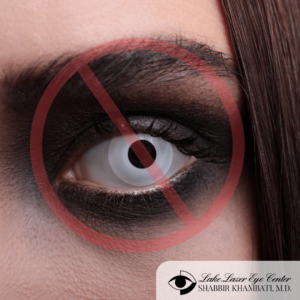
If you are thinking of wearing contact lenses to spice up your Halloween costume this year, think twice. Contact lenses are medical devices that require proper fitting and care. Using them without a prescription or proper hygiene can lead to serious eye infections or even blindness.
Even prescription contacts can cause these complications, but non-prescription are even riskier. Here are five frightening facts about contact lenses you should know before putting them on your eyes.
1. Contact lenses can cause allergic reactions.
Some people may be allergic to the materials or solutions used for contact lenses, or to the proteins that build up on them over time. Allergic reactions can cause itching, burning, tearing, or swelling of the eyes or eyelids. To prevent or reduce allergic reactions and contact lens intolerance, it is important to use hypoallergenic products, clean and replace contact lenses regularly, and follow your eye doctor’s instructions to the letter.
2. Contact lenses can cause corneal ulcers.
A corneal ulcer is a painful open sore on the surface of the eye that can result from wearing contact lenses for too long, sleeping in them, or not cleaning them properly. Corneal ulcers can cause redness, swelling, discharge, sensitivity to light, and blurred vision. If left untreated, they can lead to scarring, vision loss, or even eye loss.
3. Contact lenses can transmit parasites.
Acanthamoeba is a microscopic organism that lives in water and soil and can infect the eye through contact lenses that are contaminated with tap water, pool water, or lake water. Acanthamoeba keratitis is a rare but serious infection that can cause severe pain, inflammation, and vision impairment. It can be difficult to diagnose and treat and may require a corneal transplant in severe cases.
4. Contact lenses can change the shape of your eyes.
Orthokeratology is a type of contact lens that is designed to temporarily reshape the cornea to correct nearsightedness or astigmatism. However, these lenses can also cause permanent changes in the cornea that can increase the risk of eye infections, corneal thinning, or irregular astigmatism. Orthokeratology lenses should only be used under the supervision of an eye doctor who can monitor the effects and adjust the prescription as needed.
5. Contact lenses can make your eyes more vulnerable to UV damage.
The sun’s ultraviolet rays can harm the eyes and cause conditions such as cataracts, macular degeneration, or cancer. Some contact lenses have UV-blocking features that can reduce the amount of UV light that reaches the eye, but they do not cover the entire eye surface and do not replace the need for sunglasses or other protective eyewear.
Always follow these tips for safe contact lens wear:
- Wash your hands thoroughly with soap and water before handling your lenses.
- Clean and disinfect your lenses according to the manufacturer’s instructions every day.
- Never sleep in your contact lenses.
- Replace your lenses according to the manufacturer’s instructions.
- See your eye doctor for regular checkups.
Contact lenses can be a fun and convenient way to enhance your appearance or vision, but they also come with risks and responsibilities. Before you buy or wear any contact lenses, get a prescription from an eye doctor who can examine your eyes and fit you with the right type and size of lenses. If you experience any signs of infection or irritation, remove your lenses immediately and seek medical attention.
Want to get out of contact lenses completely? Lake Lazer Eye Center offers LASIK surgery, as well as its modern alternatives. A no-risk consultation can help you determine if you are a candidate for LASIK.
Lake Lazer Eye Center offers up-front pricing, and convenient and affordable payment plans for SoftTouch LASIK and the SMILE procedure. Dr. Khambati has helped thousands of people from all over the world escape the restrictions of glasses and contacts. In the event that you’re not a candidate for vision correction, we’ll assist you with a contact lens evaluation or a selection of designer and specialty eyewear.

 586-792-3891
586-792-3891 



